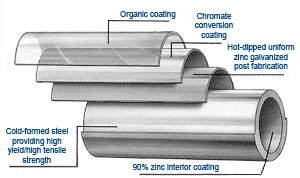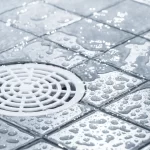Galvanized pipes were used regularly in the installation of Toronto home plumbing systems because they provided a few very useful traits – they are long-lasting and relatively inexpensive. The problem is that long-lasting does not mean indefinite, and thus the need to remove galvanized pipes. As a Toronto plumber we’ve encountered countless issues with galvanized pipes. As the name suggests, galvanized plumbing pipes are steel pipes that have been treated with a layer of zinc in order to inhibit rusting. However, as time passes this zinc layer slowly erodes away leaving the bare steel open to the water which inevitably leads to rusting and the potential for other plumbing problems.
How do galvanized pipes fail
 Although these pipes have an extensive lifespan, approximately 50 years, they will eventually fail. The failure is caused by the pipes rusting away from the inside out, not only will they rust away causing weak structural properties causing leaks and collapses but they will also develop calcium deposits inside of the pipe. With the right combination of neglect and lack of home plumbing inspection galvanized pipes can eventually become completely clogged with calcium build up resulting in low water pressure and rusty water.
Although these pipes have an extensive lifespan, approximately 50 years, they will eventually fail. The failure is caused by the pipes rusting away from the inside out, not only will they rust away causing weak structural properties causing leaks and collapses but they will also develop calcium deposits inside of the pipe. With the right combination of neglect and lack of home plumbing inspection galvanized pipes can eventually become completely clogged with calcium build up resulting in low water pressure and rusty water.
Lead plumbing is a problem in older Toronto area homes, with or without galvanized pipes, and it should be removed as soon as possible. Many homes have had their lead service pipe removed and upgraded with modern plumbing service, however for homes that had galvanized plumbing while their lead service lines were in-place there exists another area of concern. Galvanized piping has been found to accumulate lead that has leeched into the water from the old lead service lines. As the galvanized plumbing corrodes (as it inevitably will do) it releases this built up lead back into the water. Therefore, in order to completely eliminate all traces of lead contamination from it is necessary to also remove the galvanized plumbing.
“How can I tell if my home has galvanized plumbing?”
There is a very simple way you can tell if your Toronto area home has galvanized pipes installed. You’ll need to first locate where the plumbing enters into your home or property. Scratch the pipe using a key or dime and you will be able to tell by the colour of the pipe; if the pipe is a silver or gray in colour you will be able to tell that the pipe is in-fact galvanized.
Remove your galvanized pipe problems
The easiest method to solve the problem of corroding or rusting galvanized pipe is to simply have it removed. There are a myriad of local plumbers that can solve this task for you, if you’re in Toronto you can call up your local plumber in Toronto – we are extremely skilled in the removal of galvanized pipes and installation of replacement piping such as copper pipes, ABS pipes, and PEX piping.
For more information please feel free to give us a call at 416-252-5557.






